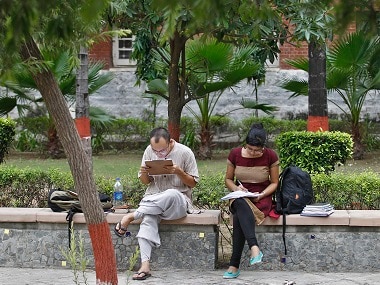A common refrain among research scholars in universities across India, especially those pursuing humanities majors, is lack of sufficient funds to attend a seminar, travel for field work or buy equipment for research. The government had, on Wednesday, announced increase in research fellowship grants in science and technology that is likely to benefit around 60,000 PhD scholars. The junior research fellows will now get Rs 31,000 per month from the previous Rs 25,000 while the senior research fellows will receive Rs 35,000, up from Rs 28,000. While the revisions are welcome and likely to encourage more admissions into PhD courses, India’s meagre investment on research and development (R&D) is stark. [caption id=“attachment_2796822” align=“alignleft” width=“380”]  Representational image. Reuters[/caption] According to the Economic Survey, the country’s spending on R&D has been stagnant at 0.6 to 0.7 percent in the past two decades and much lower than countries such as the US, China, South Korea and Israel. This stagnation accompanies the fact that India has the world’s largest population of people aged between 15 to 24 years. A 2017 report by the Ministry of Statistics and Programme Implementation (MoSPI) stated that 34.33 percent of the population will fall in this age group by 2020. This burgeoning young population suggest more opportunities for research and invention, development and ability to catapult India as one of the top innovative nations of the world. But most universities here lack serious focus on research for lack of funds, abysmal infrastructure and shortage of jobs. According to an article in The Pioneer, India scores poorly in commercialising R&D from its universities, its regulators often create antitrust and taxation hurdles in effective exploitation of foreign-owned patents on Indian soil. The Economic Survey report also states how East Asian countries like China, Japan and South Korea have seen ‘dramatic’ increase in R&D as a percentage of gross domestic product (GDP) as they have become richer. India and China had spent nearly the same percentage of their GDP on research and development, according to the UNESCO, in 2000 — India spent 0.77 percent and China 0.89 percent. But over the years, China has been steadily increasing its expenditure, spending 2.11 percent in 2016 while India has stayed in the range of 0.73 to 0.87 percent. It fell to 0.62 percent in 2015. The private sector in most countries carries out most R&D but in India, the government is not just the primary source of research funding but also a user of these funds. All said, however, India has improved in terms of publications and patents. The Survey report told how India’s share in global publications went from 3.1 percent in 2009 to 4.4 percent in 2014. No wonder then that the Prime Minister’s Science Technology and Innovation Advisory Council (PM-STIAC) had in October 2018 decided to make it mandatory for medium and large enterprises in key sectors to set aside funds for R&D after the Economic Survey pointed out the abysmal levels of investment in this area. With inputs from PTI
According to the Economic Survey, India’s spending on R&D has been stagnant at 0.6 to 0.7 percent in the past two decades and much lower than countries such as the US, China, South Korea and Israel
Advertisement
End of Article


)

)
)
)
)
)
)
)
)



